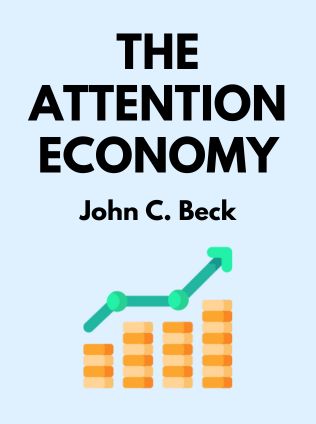
The Attention Economy
Understanding the New Currency of Business
By John C. Beck,
Published 04/2001
The Attention Economy: Understanding the New Currency of Business
By Thomas H. Davenport and John C. Beck
About the Author
Thomas H. Davenport is the Director of the Accenture Institute for Strategic Change and the author of Mission Critical and co-author of Working Knowledge. John C. Beck is a Senior Research Fellow at the Accenture Institute for Strategic Change. Both authors are renowned for their work on how information technology affects business strategy and operations. Their combined expertise offers a comprehensive understanding of the critical role attention plays in today’s business environment.
Main Idea
"The Attention Economy" explores the concept that in today's information-rich world, attention is the scarcest resource. Davenport and Beck argue that the ability to capture, manage, and sustain attention, both internally within organizations and externally with customers, is crucial for success. The book details strategies for businesses to effectively leverage attention to drive performance and competitive advantage.
Table of Contents
- What is Attention - And Why is it Important?
- Use New Technology to Grab Others' Attention and Protect Your Own
- Attention Structures: Why We Keep Paying or Lose Attention
- E-Commerce and Attention: The 'Stickiness' Factor
- Leadership: Capturing and Directing Attention
- Strategy: Allocate Attention to One or Two Frameworks
- Structure: Focusing on Certain Aspects of the Business
- The Future of Attention-Oriented Policy
What is Attention - And Why is it Important?
Attention is defined as focused mental engagement on a particular item of information. In the past, manpower and knowledge were key economic drivers, but in the current era, attention has become the critical resource. Davenport and Beck describe attention as the engine that powers business operations. Recognizing and managing attention effectively can make the difference between success and failure.
"Every business is an engine fueled by attention - the focused mental engagement on a particular item of information." - Thomas H. Davenport
The authors introduce six basic units of attention currency, which are paired into three dimensions: Captive vs. Voluntary, Aversive vs. Attractive, and Front-of-Mind vs. Back-of-Mind. These dimensions help businesses understand the different ways attention can be captured and maintained.
- Captive vs. Voluntary: Attention driven by necessity or desire.
- Aversive vs. Attractive: Attention driven by avoidance of negative experiences or pursuit of positive ones.
- Front-of-Mind vs. Back-of-Mind: Conscious, focused attention versus subconscious attention.
Use New Technology to Grab Others' Attention and Protect Your Own
The authors emphasize that the standard for what captures attention is constantly evolving. Businesses must use advanced technologies like streaming video, high-quality audio, and hypertext to attract and retain attention. Additionally, these technologies should be customized to individual needs to be most effective.
Sign up for FREE and get access to 1,400+ books summaries.
You May Also Like
Rich Dad Poor Dad
What the Rich Teach Their Kids About Money - That the Poor and Middle Class Do Not!
By Robert T. KiyosakiFreakonomics
A Rogue Economist Explores the Hidden Side of Everything
By Steven D. Levitt and Stephen J. DubnerThe Lean Startup
How Today's Entrepreneurs Use Continuous Innovation to Create Radically Successful Businesses
By Eric RiesWho Moved My Cheese?
An Amazing Way to Deal with Change in Your Work and in Your Life
By Spencer Johnson, M.D.Factfulness
Ten Reasons We're Wrong About the World – and Why Things Are Better Than You Think
By Hans RoslingMake Your Bed
Little Things That Can Change Your Life...And Maybe the World
By William H. McRaven



















